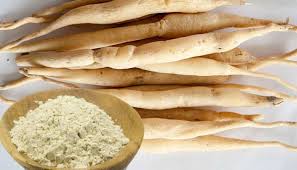Asparagus
Today let us learn about Asparagus plant. (Narayani in Sanskrit; classical name Asparagus racemosus) is a leafless, spiny, perennial climbing vine. Long and large branches growing on the trunk have many pods. Each seed has small, green, side-by-side branches. These branches are called ‘Parnkande’.

These fronds look like leaves. These ‘leaves’ are thin and look like the first leaf. Branches are usually 1 cm. There are long pointed spines which are bent downwards. These ‘leaves’ grow in clusters of 2 to 6, 2 to 3 cm. are long up to On the long branches there are sharp, curved thorns on the seeds. It wraps around the base and climbs up, forming many branches to form a small thorny bush.
Asparagus flowers, fruits, roots and seeds
Asparagus flowers are white or pink in color and come in bunches. The fruit is about the size of a pea and contains one or two pepper-sized seeds. The roots of the tree are thick, long and round and taper at both ends. These are called tubers. The tubers are white and can be up to 100 per plant. This is why this plant got its name as Shatavari. Its roots grow underground near the base. One vine sprouts many sprouts, usually 100 sprouts at a time, so it got the name Shatmula. The roots have a thin gray papule on top, and the middle part of the root is yellowish and firm. This part has to be removed while using the roots in medicine. It has a sweet taste.
Asparagus found and domestic use
Asparagus is called Asparagus racemosus in classical terminology. This plant belongs to the Liliaceae family. It is native to India and grows all over the country in tropical and temperate regions up to 4000 feet above sea level. In India, in the Sahyadri mountain range, Satpura mountain range and Konkan, asparagus vines are found on rocky ground, hill slopes and also in forests. As an ornamental plant, Shatavari is found in every household.
We have another type of Shatavari. It is called vegetable asparagus. Its scientific name is Asparagus officinalis. This plant is eaten as a vegetable of Asparagus in California in America, Milil Fort in France, Taiwan in China, Japan etc. It has long been cultivated in the cold regions of Kashmir and Bhutan. The young shoots of this vegetable are not only tasty and healthy, but also contain a lot of vitamins A and C, potassium, riboflavin and thiamine. A tasty soup is prepared from these sprouts. We recommend the Mary Washington variety of asparagus.

Asparagus is also called ‘Sasoor/Susar Muli’ in some parts of Maharashtra. And by doing this, vegetables are eaten. This plant emerges from the ground after the first few rains in Mriga Nakshatra, usually in Rana-forests or fields. And its vegetable is made by cutting the young shoots.
Asparagus Medicinal Uses
Medicinal chemicals are derived from these parts of Shatavari, such as the roots and shoots. It has a sweet and bitter taste. It reduces kapha and pitta. Shatavari Ghrit, Vishnu Oil, Shatavari Kalp and Prameh Mishtel are prepared from Shatavari. It is used to increase muscle strength. Narayan oil of Shatavari is useful for paralysis and rheumatism. Asparagus tuber contains saponin, glycosides, phosphorus, riboflavin, thiamine, potassium, calcium and other chemicals. The tuber is used for biliousness, fever, iron deficiency, kidney stones, epilepsy and blood purification. The tuber is used to get more milk in animals especially cows, buffaloes. Shatavari Kalpa is made from Shatavari tubers. Its Narayan oil prepared from Shatavari is effective against paralysis and rheumatism. It also works as a memory enhancer. It helps women in all three complaints of excessive discharge during menstruation, young girls who are newly menstruating, and menopause. It is used for easy delivery of women.

Asparagus cultivation
After planting it survives continuously for 14-15 years in the soil and continues to generate income as it is horticultural. Shoots are produced one year after planting. All pharmacies in India buy asparagus sprouts. They are in demand outside India as well. Allopathy, Ayurveda, Homeopathy use Shatavari roots.
Useful parts of asparagus
root
Prepare from the root
leaf
Paste
shatavari churna
How to use Shatavari ?
You can use Shatavari in this way:-
Juice- 10-20 ml
Decoction- 50-100 ml
Powder- 3-6 grams
Where is grown?
in India is cultivated in many places. It is cultivated in the Himalayan regions at an altitude of up to 1500 meters. Asparagus is mainly found in the upper Gangetic plains, and the plateau parts of Bihar.
source : Wikipediya
Read More –
Faq –
1 How long are asparagus leaves ?
2 Where is asparagus found in India ?
3 What are the uses of Narayani Oil ?